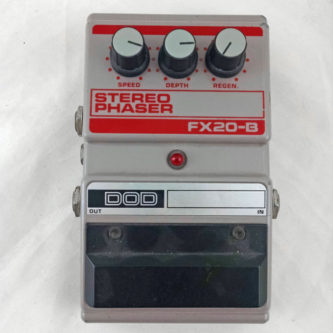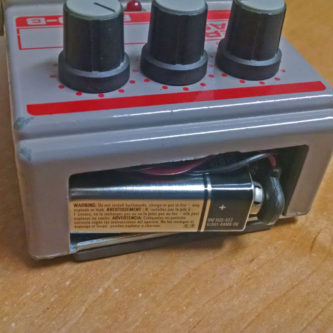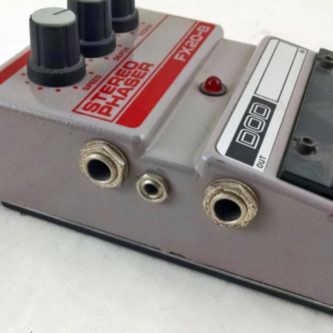Who has a soft spot for the DOD FX series? If you are a guitarist of a certain age you’ve probably owned a few of these. Maybe you still have one in the closet covered in grayish brown dust and almost certainly missing the battery door.
When DOD got their start in the mid 1970s their effects often had a… how shall I say it? A striking similarity to MXR’s offerings. By the early 80’s they were garnering more “inspiration” from another effects heavyweight: Boss. If not by internal design, the similarities in external aesthetics and functionality were apparent.

The under loved FX20B
The FX20B is no exception to this rule. While some of the old FX series like the FX69 Grunge generate universal hatred, the FX20B seems to bring up no strong feelings at all. Is it so unremarkable guitarists can’t even muster up some universal scorn? Maybe some were confused because it started out as a phaser, but later rebranded – the “Phasor.” Perhaps this was the precursor to labeling controls with absurdities like “Butt” “Guts” or “Pasteurization.”
You can still find them for $35 on your local craigslist. The bypass switch is sketchy. There’s some rust on the jacks. A screw might be missing from the back cover. The velcro on the back is gummed with carpet dirt and dog hair, but that’s the world these old and under-loved pedals live in. In a day of multi-tap power supplies the 1/8th inch power connector isn’t exactly convenient. You want it? Don’t worry about rushing across town to scoop it up. It will still be for sale a week from now.
I have an unhealthy affection for the FX20B Stereo Phaser and even for the the whole FX lineup. The FX20B was the first pedal I ever owned, and that’s why it’s the first pedal to emerge from the dark corners of The Effects Closet.
So does it actually sound good?
With stompboxes tone and “good” are are a squishy thing. It’s always in the ear of the beholder. Don’t expect a Phase 90 or Small Stone. It has a personality and you’ll either get along with it or you won’t. Due to its sheer ubiquity at the time it must have been used on a famous recording. Maybe it was, but I’ve never heard an artist singing its praises.
One test I use to judge phasers is how well they work with overdrive. This is one area where the FX20B shines. Running it before or after overdrive never leaves your tone feeling hollowed out or overly accentuated along any part of the frequency spectrum. That’s a lot to ask of any phaser under $50.

The always missing battery door
There is a raw chewiness to the phasing. Part of this is because the FX20B is a six stage phaser, so it has a wetter sound than any four stage phaser. The other part is due to its low input impedance. DOD listed the input impedance as 500Kohms. In reality it’s only 100Kohms. If your guitar is running straight into this pedal there will be noticeable high end loss. It’s like your guitar signal was going down the high pressure pipe of your guitar cable and landed in a pool of cold jello.
Unfortunately the impedance issue is there even when the pedal is bypassed. Luckily If you have a buffered pedal somewhere before this FX20B the impedance issues shouldn’t matter.
The quirks
The actual phaser effect isn’t terrible, so long as you aren’t expecting it to be something it’s not. It has quirks. The phaser sweep spends more time at the bottom than the top. The non-symmetrical sweep also seems to rise more slowly than it falls. The eccentricity is especially noticeable at slower speeds.
The dark tone that helps it cooperate with gain is not as friendly to clean signals. It’s definitely better suited for brighter guitars and single coil pickups. With humbuckers there’s little high end swirl and a whole lots of viscous low end goopiness. Unfortunately it’s less like a hot fudge sundae, and more like cold 5 day old leftover tuna casserole. Mmmmm just like mamma used to make. (Sorry Mom, that stuff was terrible.)
The controls feel weird. Especially the depth knob which also raises the phaser sweep. This is an oddity I’ve never experienced with other phasers. On some phasers, along with a depth control, you’ll also have a manual or frequency control. Turning the depth knob up on the FX20B is like turning both controls up at the same time. The truth is though, you’ll probably find yourself cranking the depth setting and wanting to break the knob off. There’s really no other setting for this knob.
It doesn’t do subtle.
Some phasers give you subtle watery modulation. Others can cop a classy vibrato or rotary effect at the right settings. With six phaser stages you’ll always know this thing is on. You wanted a phaser though, right? When you really dig into the strings there’s some grit. Somehow it sits within the sweep feeling natural though. It’s not the high end razor clipping you’d expect out of a bargain basement pedal.
Lovable?
This pedal brings back memories of being a teenager in my bedroom playing along to The Cure, The Banshees and The Cars. It was the first pedal I ever owned. It’s probably a pedal more suited for an ultra low budget Pink Floyd cover and, or DIY univibe modding. For me objectivity is overcome by sentimentality. I rarely use this pedal, but plugging it in brings back those same feelings you get listening to albums you had on auto-reverse & replay in your 1980’s cassette deck. Would I write an album based around this pedal? Um, no! It’s pure nostalgia, but isn’t that a small part of the affinity we have for better loved classic vintage gear?

The ever so convenient 1/8th inch power plug.
